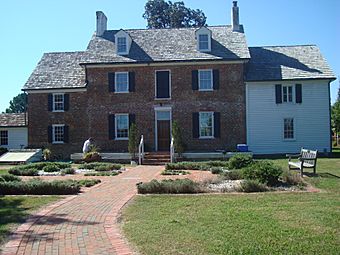Ferry Plantation House facts for kids
|
Ferry Plantation House
|
|

Ferry Plantation House
|
|
| Location | 4136 Cheswick Lane Virginia Beach, Virginia |
|---|---|
| Built | 1830 |
| Architect | McIntosh, George |
| Architectural style | Federal |
| NRHP reference No. | 04001545 |
Quick facts for kids Significant dates |
|
| Added to NRHP | January 20, 2005 |
The Ferry Plantation House, also known as Old Donation Farm, Ferry Farm, or Walke Manor House, is a historic brick house in Virginia Beach, Virginia. This special place has a long history, going all the way back to 1642. That's when Savill Gaskin started the second ferry service in the Hampton Roads area.
This ferry helped people travel across the Lynnhaven River. It took them to the local courthouse and to different farms along the water. To call the ferry, people would fire a cannon! The ferry had 11 stops along the river. The very first ferry service nearby was started by Adam Thoroughgood.
Over the years, the Ferry Plantation House has been many things. It was a large farm, a courthouse, a school, and even a post office. Today, it's a museum and a place for learning. They even have a Summer History Camp there. Kids can learn what life was like in the 1700s and 1800s. People also say the house is home to 11 spirits!
Contents
What is the Ferry Plantation House Like?
The land where the house stands was first cleared by local Native American tribes hundreds of years ago. Many old tools and items from their time have been found here. The third courthouse for Princess Anne County was built on this spot. It was the first brick courthouse in the county and even had stocks and a pillory for punishments. This courthouse was used from 1735 until a new mansion was built.
The Walke Mansion, owned by William Walke, stood here from 1751 to 1828. Sadly, it was destroyed by a fire on September 12, 1828. William Walke might have run a small inn here during the American Revolution.
The Current House and Its Features
The house you see today was built in 1830. It's made of brick in the Federal style. All the bricks used came from the ruins of the old Walke Mansion. In 1850, a new section was added to the west side of the house.
The house has 10 rooms with beautiful wood floors made from heart-of-pine. Many parts of the house are still original. It was once covered with a special plaster made from oyster shells. The back of the house looks out over the western part of the Lynnhaven River.
The house itself sits on a small piece of land owned by the city. It's surrounded by a larger open area, like a park, owned by a neighborhood group. There are small gardens on the property. In the backyard, there's a very large Southern Magnolia tree. It was planted on April 6, 1863, by Sally Rebecca Walke to remember her fiancé.
Saving the Historic House
Virginia Higgins lived in Ferry Plantation until 1986. After she moved out, the house was empty for 10 years, from 1986 to 1996. A group of people in the community worked hard to save the house from being torn down around 1996.
Some investors bought it in 1994, but their plan to sell it fell through. The Virginia Beach City Council decided the house couldn't be a private home because of rules about its history. So, in June 1996, the house was given to the City of Virginia Beach. Then, a group called the Friends of the Ferry Plantation House, Inc. started fixing it up. They worked with the city to restore it. You can still see old courthouse bars on one window today!
Because of its history, the house was added to the Virginia Landmarks Register in 2004. It was also listed on the US National Register of Historic Places in 2005.
Are There Ghosts at Ferry Plantation House?
Many people believe the Ferry Plantation House is haunted by 11 spirits! You can even take special tours to learn about them, including one around Halloween called "The Stroll of Lost Souls."
Some of the reported spirits include people who died in a shipwreck near the ferry landing in 1810. There's also a former slave, and Sally Rebecca Walke, who is said to be sad about her fiancé, a soldier who died. Another spirit is the Lady in White, who supposedly broke her neck falling down the stairs. The artist Thomas Williamson, who owned the Manor House and was married to a Walke, has also been seen painting at the top of the stairs. Groups who study ghosts often visit the house to do research. People have even reported hearing the sound of dragging chains, which might be from the days when it was a courthouse.
Grace Sherwood, known as the "Witch of Pungo", was tried near here a long time ago. The museum holds an annual Grace Sherwood Festival. This event includes a play that shows what her trial might have been like. The actual trial happened in the river, about 200 yards from where a private home now stands. The house has a Red Maple tree and a marker in the side yard to honor Grace Sherwood.
Images for kids
See also
- List of the oldest buildings in Virginia
- National Register of Historic Places listings in Virginia Beach, Virginia
- List of reportedly haunted locations in the United States






